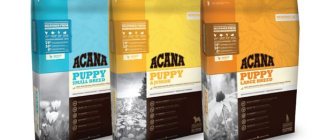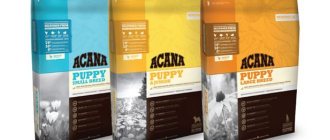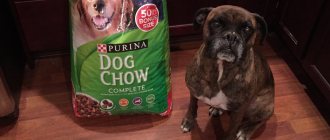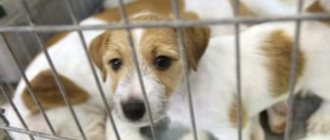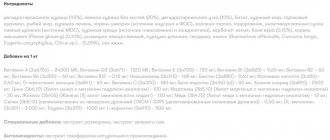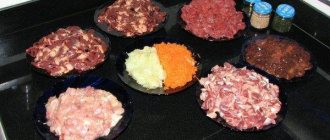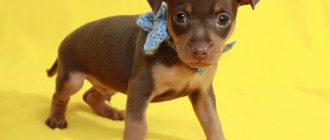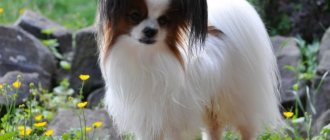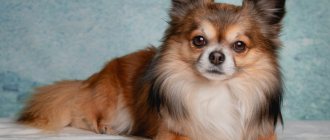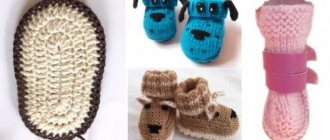Proper feeding is the source of your pet's longevity!
Russian toy Elaida – “Light Breakfast” – Go to the photo album page
Like any owner of a miniature dog, you want your pet to grow up healthy and full of energy. And in order for your Chihuahua or Toy Terrier to feel good, you need to feed it a balanced diet that provides all the needs of a growing and developing body. What to feed - dry food or home-made food - is up to you: there is no unanimity among experts on this issue. Each method has its pros and cons, but we will talk about them later. In this article we will tell you about the rules that must be followed when feeding your pet homemade food. What should a small dog's table be like? Let's find out...
Regularity of feeding
The regularity of feeding a Chihuahua or Russian Toy directly depends on the age of the dog. Veterinarians are unanimous in their opinion that it is best to feed a small dog puppy according to the following scheme:
- 1-2 months - 6 times a day;
- 2-3 months - 5 times a day;
- 3-4 months - 4 times a day;
- 4-10 months - 3 times a day;
- 10-18 months - 2 times a day.
From one and a half years old, a small dog can be fed once a day. However, this should not be done if your pet has problems with the gastrointestinal tract or liver. An acceptable option is the one where the dog has two feedings per day.
Volume of one serving
The amount of food eaten by a small dog is selected strictly individually, depending on the needs of the dog’s body. It is considered unacceptable to overfeed a dog, which leads to obesity and problems with the gastrointestinal tract, lungs and heart, and underfeeding, which can cause dystrophy and disorder of the nervous system.
If you watch your Chihuahua or Toy Terrier carefully, you will notice that the small dog's sides become slightly enlarged after eating. Keep an eye on this indicator. Normally, a dog’s sides should neither stick out much nor be sunken.
How much food should you give your dog?
How to choose the ideal amount of food for your dog? It is necessary to consult with a specialist or carefully observe the behavior of the animal at the time of feeding.
If the dog quickly eats the offered amount of food and the bowl remains clean, then at the next feeding you can slightly increase the portion. If after 15-20 minutes some of the food remains in the bowl, then the next portion should be slightly reduced.
This is important: You should carefully monitor your four-legged friend. Many individuals are prone to gluttony. The result is excess weight, which negatively affects the state of the cardiovascular, musculoskeletal and other systems.
If you gain extra pounds, you should increase your dog’s physical activity and reduce the portion.
What can you feed a chihuahua and toy terrier?
Let's talk about such an important topic as the diet of your small dog. First of all, I would like to note that you can start feeding your dog from three weeks of age. The first foods introduced into a dog’s diet are porridge and cottage cheese. From 1 month, meat is gradually introduced into the dog’s diet.
When choosing a diet for a Chihuahua and Russian Toy Terrier, you should remember that the dog, no matter how large or small it is, is a wolf, so the basis of your pet’s diet should be protein food in an amount of at least 2/3 of the total diet . Protein foods include meat, offal, fish, poultry, cottage cheese, kefir, milk, eggs. Some veterinarians and experienced dog breeders recommend giving all these products exclusively raw. However, there is an alternative opinion on this matter. Opponents of raw food eating claim that raw foods (meat, fish, poultry, offal) may contain helminths or their larvae, which causes significant harm to the animal’s body.
Let's take a closer look at the foods that should be in the diet of your Toy or Chihuahua.
- Meat. The meat is given either in the form of pieces or planed. It is not advisable to give minced meat to a small dog: it is poorly digestible. For a small dog, the pieces of meat should be finely chopped. Eating fatty meat is unacceptable. Meat broth can be one of the options for diversifying your pet's diet. At the same time, it is not recommended to cook broth with bones: very frequent use of such broths leads to digestive problems in Chihuahuas and toy terriers. The ideal option is a broth based on cartilage, which contains a lot of collagen, which has a beneficial effect on the growth of bones and ligaments of a small dog. How much meat should a Chihuahua and Toy Terrier have in their diet? From ¼ to ½ of the weight of the entire diet. It should be borne in mind that a young growing body needs more meat than an old and sedentary dog.
- Offal. The liver and heart are the most useful by-products. The liver contains a large amount of vitamins A and D. The offal is thoroughly boiled and given no more than 1-2 times a week, but in a volume 1.5 times greater than the volume of meat.
- Fish. Small dogs, like the Chihuahua or Russian Toy Terrier, are given only sea fish - cod, hake, pollock. Containing a small amount of fat, they include the necessary amount of healthy fatty acids, as well as iodine and phosphorus necessary for the body. Fish should be offered no more than 1-2 times a week.
- Dairy products. Should be presented in the dog’s diet in the form of kefir and cottage cheese. It is not recommended to offer milk to small dogs older than 2 months: upon reaching this age, milk begins to be poorly absorbed by the body and does more harm than good. As for eggs, they are introduced into the diet raw and no more than 1-2 times a week.
- Cereals. Contain fiber necessary for intestinal function. Rice, rolled oats, and buckwheat are preferred in the diet. But millet and pearl barley are poorly absorbed by the body of a chihuahua and toy terrier, so it is better to avoid their use. Cereals should make up 1/3 of a small dog's diet.
- Vegetables and fruits. Compared to other products, they are less absorbed. As for vegetables, a small dog can consume carrots, which are an essential source of vitamin A. Carrots are given raw, thoroughly grated. It is best offered in combination with vegetable oil, since the vitamins contained in vegetables and fruits are best absorbed on an oil basis. You can also offer your Chihuahua and Toy Terrier cabbage, but not the stalk, because they contain the main nitrates that may have been added to the cabbage. But it is better not to introduce potatoes into your dog’s diet. In addition to the danger of poisoning with solanine contained in some tubers, potatoes interfere with the absorption of B vitamins. Cauliflower, zucchini, and tomatoes can also be introduced into the diet of a small dog. It is permissible to eat an apple as a fruit. Vegetables and fruits can make up ¼ -1/3 of the diet.
Here are the main foods that should be included in your small dog's diet.
The benefits of natural nutrition
The most important argument in favor of natural food for dogs is their origin. The distant ancestors of our pets are predators. They hunted and got their meat. Sometimes, after an unsuccessful hunt, they had to eat plant food (fruits and berries that fell from trees). But nature did not provide a ready-made solution in the form of food. Therefore, meat is the most natural and natural product for feeding a dog.
The structure of the jaw and the features of the digestive system are not designed for eating small, soft or liquid foods. When a dog eats meat, the teeth are naturally cleaned of plaque, and the high acidity of the stomach is aimed at processing rough muscle fibers. Natural food promotes proper digestion and the functioning of all organs.
A well-composed natural diet satisfies the body's needs for proteins, fats, and carbohydrates. It contains essential vitamins, minerals and trace elements. Natural nutrition is varied and allows you to easily replace products in case of intolerance or dog preferences. You always know what exactly your pet eats and control the quality of the products yourself.
What should you not give to Toys and Chihuahuas?
What should you never feed your pet if you want it to have health and longevity? Here is a sample list of foods that should be excluded from a small dog’s diet:
- Bones. Forget about the existence of bones. Sharp bone fragments can pierce or injure a dog’s stomach, get stuck in the throat, and damage the health and life of your pet.
- Pork. Its meat is extremely fatty, and this will place a huge burden on the liver of a small dog.
- Raw river fish. As a rule, it is affected by helminths. In addition, river fish contains a large number of bones, so its consumption is generally undesirable for small dogs.
- Peas, beans, legumes. They create problems with the removal of gases from the intestines.
- Alcohol. In addition to all the harm that alcohol causes to the body of a small dog, and which we already know enough, keep in mind that alcohol is not broken down in the dog’s body and is highly addictive.
- Sweet. Causes watery eyes in small dogs.
- Salty. Firstly, it puts extreme strain on the kidneys, and secondly, it causes salt deposition and increased blood pressure. There is no need to add additional salt to the food you prepare for your Chihuahua and Toy Terrier. It contains a sufficient amount of salts necessary for the body. This also includes the ban on spices.
- Fried, fatty. Causes stress on the liver.
- Pasta, white bread. They contain a large amount of “simple” carbohydrates, which contribute to the accumulation of fat mass.
- Sausage and frankfurters. They put a lot of stress on the liver.
Recommendations for feeding dogs at home
Basic rules that must be followed when feeding chihuahuas and toy terriers with homemade food.
- A small dog should be fed only freshly prepared, high-quality food.
- You cannot feed your dog from the common table. The food you eat does not suit your Chihuahua or Toy Terrier either in terms of the amount of salt, or in terms of fat content and spice.
- If you decide to switch your dog to ready-made industrial food, the transition should occur gradually. Please keep in mind that it is not recommended to mix homemade food and food with each other, nor is it recommended to mix food from different companies.
- Never leave uneaten food in the feeder. It can turn sour, which will cause poisoning in the dog, and in addition, it will accustom the small dog to irregular and disordered eating.
- After your small dog has eaten, give him time to rest. You should not immediately go for a walk or engage in outdoor and active games.
- Your dog's main drink should be fresh water. Keep in mind that small dogs require more fluid than large dogs.
- The diet of Chihuahuas and Toy Terriers must be balanced, that is, contain all the necessary proteins, fats and carbohydrates in the required volumes and proportions.
- In the autumn-winter-spring period, add special vitamins and microelements to your diet in the form of tablets and powders. After all, homemade food, unlike industrial food, is not saturated with all the necessary substances.
- Be sure to monitor your small dog's weight and health. After all, poor nutrition will affect your appearance and well-being.
General principles
Some owners confuse natural feeding with table food. This is wrong. Even the best food “for people” is harmful to pets. Prepare separately for dogs.
On a natural basis, the following rules are adhered to:
- components are prepared separately and mixed in a bowl before feeding;
- the dog should eat a portion in one “lick”: if the food remains, it means the dog is overeating, and over time he will develop obesity;
- provide constant access to clean water;
- Vitamin complexes are introduced into the diet - it is almost impossible to independently calculate the amount of nutrients in the daily menu;
- fermented milk and meat products must be given in different doses;
- meat and offal are given raw, after freezing in the freezer for 2 - 3 days;
- vegetables are grated or chopped;
- Boil the cereals, or in broth;
- the meat is cut into pieces of different sizes, taking into account the size of the pet - so that he can chew them;
- foods are not salted or peppered;
- Do not mix natural and dry food - this will lead to problems with the gastrointestinal tract.
All food must be fresh. It is stored in the refrigerator for no more than two days.
The dog is transferred from dry food to natural food gradually, over 2 weeks. Additionally, probiotics are given, otherwise the functioning of the digestive system can be undermined.
We recommend reading: Pancreatitis in dogs - symptoms, treatment, prevention
